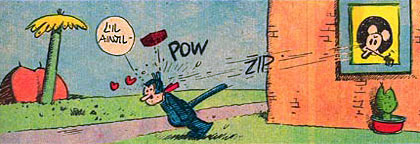comic strip
Book with brick

But ink can depict. If it happens to depict words, those can establish an off-image connection between what is seen in the image and what is thought imagelessly with words. Off-image, you can imagine a cat clawing open a book whose title includes a word: Krazy. Then you can read the book and learn the word.
George Herriman, Krazy’s creator, was a black man passing as white. With its never-changing but ever-morphing language and its never-changed theme of love met with a thrown brick, his daily comic strip must have borne a connection with the secret life of his mind. Herriman gave the secret a black disguise and a blurred name: kat. Thereafter, day after day, pulsed by clock and calendar, George Herriman would sit before his drawing board and throw an image of a brick toward kat’s head. Day by day, it seemed that kat’s love-words were about to echo from the brick’s arriving surface. But the echo never came and the brick would always bounce off kat’s skull. The calendar page would turn; daily between 1913 and 1944, kat would speak love and then his silent brick would fall. But the next day, undyingly, as if its trajectory were a route of spring hope, the fall would be redrawn.




